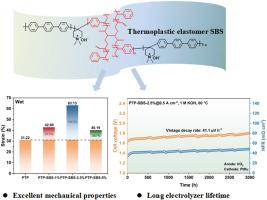Mechanically robust and chemically stable poly(aryl piperidinium)-SBS copolymer anion exchange membranes for 3000-h durable alkaline water electrolyzers
IF 9.5
引用次数: 0
Abstract
Anion exchange membrane (AEM) is a core component of potentially more efficient and cost-effective anion exchange membrane water electrolyzers (AEMWEs), which combine the advantages of traditional alkaline water electrolyzers (AWEs) and proton exchange membrane water electrolyzers (PEMWEs). Despite extensive research efforts in recent years, AEMs still face significant challenges, particularly insufficient alkaline stability and limited dimensional/mechanical stability. In this work, we enhanced the mechanical and alkaline stability of AEMs by incorporating the thermoplastic elastomer polystyrene-block-polybutadiene-block-polystyrene (SBS) into the poly (terphenyl piperidinium) (PTP) matrix. The optimal PTP-SBS-2.5 % membrane exhibits outstanding dimensional stability (9.4 % swelling at 20 °C), robust mechanical properties (tensile strength of 51.5 MPa and elongation of 63.1 % at break in wet state), low alkali absorption (0.875 %) and exceptional alkaline stability (92.4 % conductivity retention after 1500 h). Notably, the membrane demonstrates stable operation in AEMWE for over 3000 h with a low voltage decay rate of 41.1 μV h−1. These results highlight the significance of SBS in enhancing both the alkaline stability and mechanical performance of PTP-based AEMs.

机械坚固和化学稳定的聚芳基胡椒啶-SBS共聚物阴离子交换膜,用于3000 h耐久碱性水电解槽
阴离子交换膜(AEM)结合了传统碱性水电解槽(awe)和质子交换膜水电解槽(PEMWEs)的优点,是具有更高效率和成本效益的阴离子交换膜水电解槽(AEMWEs)的核心部件。尽管近年来进行了广泛的研究,但AEMs仍然面临着重大挑战,特别是碱性稳定性不足和尺寸/机械稳定性有限。在这项工作中,我们通过将热塑性弹性体聚苯乙烯-嵌段聚丁二烯-嵌段聚苯乙烯(SBS)加入聚terphenyl胡椒啶(PTP)基体中来提高AEMs的机械稳定性和碱性稳定性。最佳的ptp - sbs - 2.5%膜具有出色的尺寸稳定性(在20°C时溶胀率为9.4%),良好的机械性能(湿态断裂时拉伸强度为51.5 MPa,伸长率为63.1%),低碱吸收率(0.875%)和优异的碱稳定性(1500 h后电导率保持率为92.4%)。值得注意的是,该膜在AEMWE中稳定运行超过3000 h,电压衰减率为41.1 μV h−1。这些结果突出了SBS在提高ptp基AEMs的碱性稳定性和力学性能方面的重要意义。
本文章由计算机程序翻译,如有差异,请以英文原文为准。
求助全文
约1分钟内获得全文
求助全文

 求助内容:
求助内容: 应助结果提醒方式:
应助结果提醒方式:


